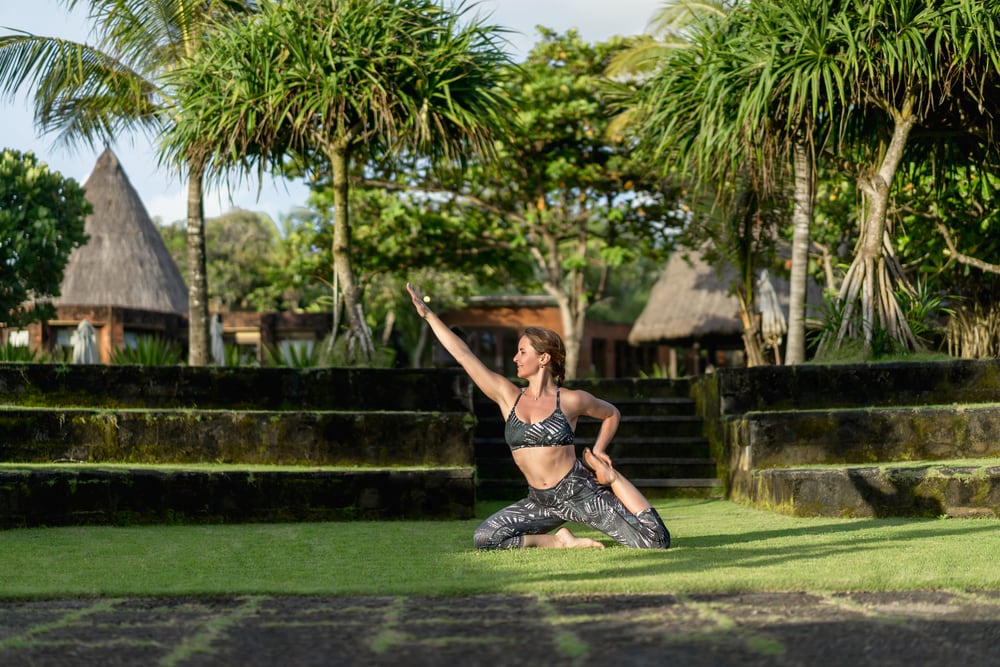This article outlines an easily-practiced grounding meditation.
There are two stages: the first stage involves settling yourself into a relaxed state whilst the second stage eases your attention deep into your body.
These two practices work together to create a sense of calm and stability: beneficial mental qualities to have in any situation.
What Does Grounding Mean?
 Describing what grounding means precisely is more difficult than it sounds. It’s almost like talking about an intense spiritual experience with a friend, but you don’t have the words to describe it.
Describing what grounding means precisely is more difficult than it sounds. It’s almost like talking about an intense spiritual experience with a friend, but you don’t have the words to describe it.
But for the most part, everyone can agree that feeling grounded comes down to a feeling. At the center of this feeling is calmness and being content.
You are completely aware of your surroundings, and that you are a spiritual entity inside of a physical being. In order to preserve this vessel, you have to take care of it.
Yes, this includes following a healthy lifestyle. But it also includes taking a few minutes out of each day to ground yourself and connect with the earth.
More specifically, you want to connect with the natural beauty around you and find peace with your thoughts.
Chances are this feeling sounds very familiar, and it’s because it can happen when you’re not really thinking about it.
How long it lasts can’t really be determined, but there are ways to create this feeling on demand (some of which are discussed in this article).
When you are able to ground, you put yourself in a position to focus better and get more perspective about life in general.
Why Is Grounding Important in Meditation?
When it comes down to it, there are many reasons why people choose to ground on a regular basis.
For example, going through emotional or financial distress can be good reasons for grounding. But you can also tap into this power when you feel confused, angered, depressed, or when you sense there is some imbalance that needs to be corrected.
Essentially, when you don’t feel at your best, it’s a sign to ground.
Benefits of Grounding Meditation
- Mindfulness meditation (the basis of the techniques outlined in this article) has been proven to reduce stress at a rapid pace and increase subjective well-being. Extended periods of calm and relaxation.
- The purpose of these meditations for grounding is to reconnect with that felt sense of stability that resides in each of us. When we feel that we’re not being pulled to and fro by the circumstances of our life, either good or bad, and we can act with greater clarity and wisdom.
- Connecting with this foundation, this firmness, also means that we are less likely to fall into despair as we come up against the painful emotions that are part and parcel of everyday life. This emotional non-reactivity has also been researched.
- You’ll have more control over your emotions and a clearer perspective of the world leading to more confidence to speak your mind. You’ll be better able to communicate your mind immediately. Prevent negative thoughts and judgments from creating an imbalance. You’ll be more in-tune with your energy and what you can achieve with it.
Is It Better to Ground at Specific Times?
 In all honesty, the best time to ground is when you feel you need it. So, no, there are no rules as to when you should use this natural gift.
In all honesty, the best time to ground is when you feel you need it. So, no, there are no rules as to when you should use this natural gift.
However, there are recommended times for grounding:
1. When you know you will be participating in something spiritual, take a moment to ground yourself first and connect with the earth. This will help you to be present for the experience, both physically and mentally.
2. The second time is when you undergo a spiritual, emotional, or physically challenging event.
Some examples of when to ground immediately before and after include:
- When you are about to leave your home
- Take on something with potential danger, like driving through traffic
- You live through a scenario that rattles you emotionally or physically
- When you have a serious and intimate discussion with someone
- When you need your mind to be sharp and focused
- When you start to feel displaced, confused, or you simply don’t have energy
Naturally, there are many more examples that can be listed, but you get the idea. And I like to think grounding should be implemented as you see fit. As long as you take advantage of grounding, it’s all that really matters.
Are There Scripts & Techniques for Grounding?
1. Put Yourself Inside Nature
This is a technique that should not take more than five minutes to do, and all you need is something from nature.
Even if you only have a view of the beautiful rainy clouds outside, you have a way to connect. Alternatively, you can step outside and find a spot underneath some trees, or you can walk down a peaceful trail.
The point is that you want something that is naturally bound to earth to be within reach, view, or smell. And when you find it, you should use it to ground yourself.
For instance, taking your lunch break in the park means sitting in the sun, and listening to the sounds of the animals. You’ll also feel the breeze, along with the scent that only fresh air can bring.
Take a few deep breathes, clear your mind, and absorb these elements through your senses, and be aware of the process. Become conscious that you can interact with these Earth elements because you are a part of them.
Don’t talk to anyone while you do this. Just allow yourself to be in the moment.
Remember, you choose how complex this process needs to be. And the more you try to think about it, the less it’s going to work. Instead, allow our consciousness to roam free and take in what nature is offering.
2. Visualization
Some people have a better connection with their imagination, which is why grounding can also be useful once you tap into your vivid imagery skills. If I could use myself as an example, I like to visualize myself as a tree, and the more detail I see, the more effectively I ground myself.
Simple Grounding Meditation Script
Part 1: Body Awareness
It’s important not to place any heavy demands on yourself. The purpose is to relax.
Whilst having a specific meditation object, such as the breath, is beneficial for certain practices, it does increase the likelihood of becoming too tense of frustrated in the attempt to stay focused.
By loosely letting your awareness rest first in the body and second on the breathing, you often overcome this hurdle.
Follow these simple guidelines:
1. We are looking to foster three qualities: ease, stillness, and alertness.
2. Begin by taking a handful of deep, calming breaths. Let your awareness gently “fill” your body with each one. Let each exhalation be a “letting go.”
3. When you feel comfortable, allow your attention to loosely rest on the sensations of the breathing as they manifest in your body during each inhalation and exhalation.
4. Whenever you notice that your attention has drifted, gently return to your bodily sensations. Counteract distraction with deeper relaxation, not by wilfully focusing, which can often lead to more tensing.
Part 2: Rising & Falling of the Abdomen
Focusing on the belly is an excellent way to cultivate a sense of being grounded. It is almost as though you are pulling your awareness deep into your body.
Follow these simple guidelines to get started:
1. Adopt a sitting posture (lying down and sitting on a straight back chair are also fine) and close your eyes.
2. Place your attention on your abdomen, at a point that readily stands out to you.
3. As the abdomen rises, observe the movement from start to finish. As it falls, continue to simply observe.
4. Don’t try to change or alter your breathing.
5. Noticing that you have fallen into distraction or started to provide a commentary to the movements is a sign of success in your meditation. Simply return to the non-judgemental, present-moment awareness of the rising and falling of your belly. This “returning” is the essence of mindfulness.
6. Each time you “return” your attention it is as though you are lifting a weight and strengthening the muscle of your mind.
7. You may find it helpful to label the movements (rising, falling, rising, falling) silently in your mind for a while.
8. Before opening your eyes, rest in the feelings of centered-ness and calm for a few moments.
References
The Attention Revolution by B. Alan Wallace.

